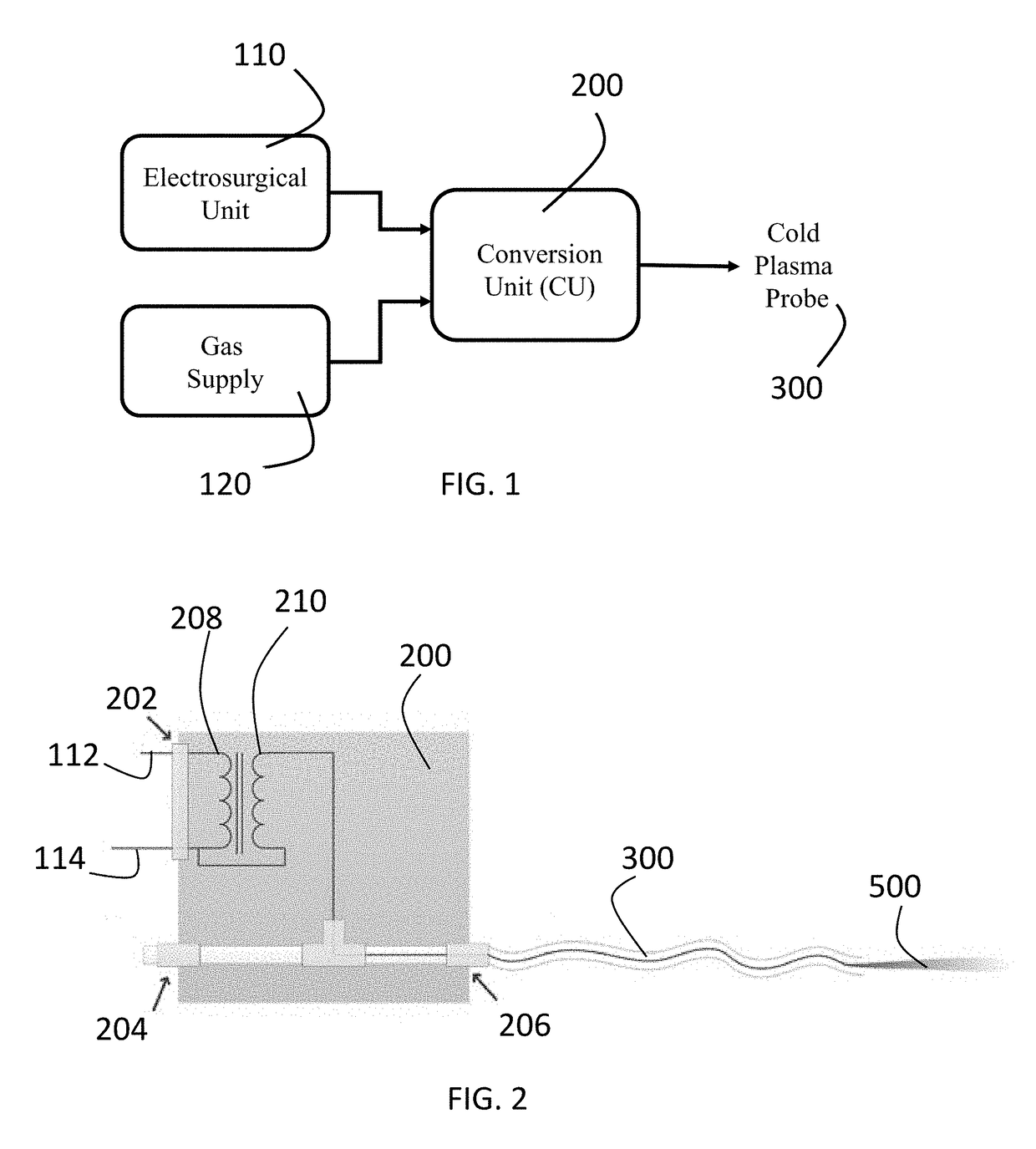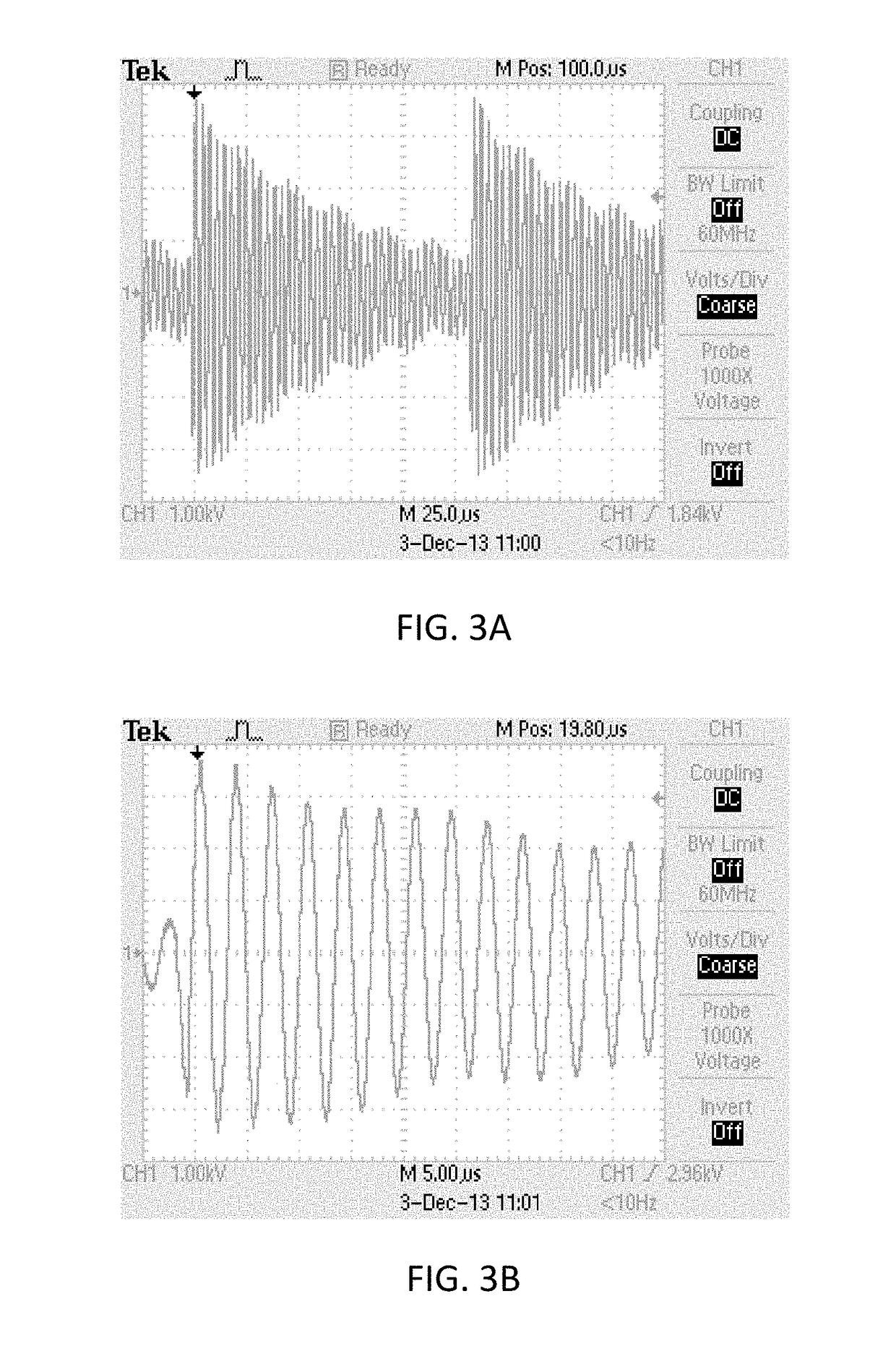System and method for selective ablation of cancer cells with cold atmospheric plasma
a technology of selective ablation and cancer cells, which is applied in the field of systems for producing cold plasma, can solve the problems of undefined mechanism of action and the pathways involved previously
- Summary
- Abstract
- Description
- Claims
- Application Information
AI Technical Summary
Problems solved by technology
Method used
Image
Examples
example 1
[0063]The transformer in the CU utilizes primary coil with N1=30 turns of AWG 30 magnet wire and secondary coil with about N2=250 turns of AWG 36 magnet wire. Ferroxcube core UR64 / 40 / 20-3C90 was used. Insulation between the windings was up to 10 kV and between the windings to the core—up to 7 kV.
[0064]The Conversion Unit in this embodiment produced high voltage with RMS up to about 2 kV and frequency about 150 kHz. Power delivered into cold plasmas was <5 Watt. The dependence of RMS output voltage of Conversion Box vs. input power setting on ESU is show in FIG. 2.
[0065]CPP shown in FIG. 8 can utilize one-electrode or two-electrode configuration. In one-electrode configuration—high voltage electrode can be placed inside the flexible tube used for the Helium supply or embedded in the tube's wall. In two-electrode configuration high voltage electrode is placed inside the tube and grounded shield is embedded in the tube walls.
[0066]The schematic view of the Conversion Box and 3 meter lo...
example 2
Cell Culture.
[0067]The human ZR-75-1 Breast Cancer Her2+, Er+, Pr+ epithelial cell line (referred as ZR-75 in the article) was cultured at 37° C. in 5% CO2 in a RPMI medium, supplemented with heat inactivated 10% fetal bovine serum and with 5% penicillin-streptomycin and gentamycin (Sigma Aldrich, MO). MCF-12 normal Breast epithelial cell line (referred as MCF in the article) was cultured using 1:1 DMEM and Ham's F12, 20 ng / ml HGF, 100 ng / ml cholera toxin, 0.01 mg / ml Bovine Insulin, 500 ng / ml hydrocortisone, 5% of 95% horse serum (Sigma Aldrich, MO). The cell lines were purchased from (American Type Culture Collection, Manassas, Va.). The coverglass 24 well plates were coated with fibronectin for 30 minutes before seeding the cells onto the plates. Cells were seeded at a density of 1×105 cells / well in 24-well plastic cell culture plates and used at ˜40% confluence, as determined by Zeiss phase-contrast microscopy.
Cold Atmospheric Plasma Treatment.
[0068]The multiwall plate was placed...
example 3
[0074]Immortalized Human RPE (ARPE-19) and Y-79 retinoblastoma cells were purchased from American Type Culture Collection (ATCC, Manassas, Va., USA), cultured and propagated in Dulbecco's Modified Eagles Medium or RPMI-1640 (DMEM; Invitrogen-Gibco, Life Technologies, Long Island, N.Y., USA) respectively. The medium contained 10% FBS for ARPE-19 and 20% FBS for Y-79 (Sigma Aldrich, St Louis, Mo., USA), 100 IU / ml penicillin-streptomycin, 50 ug / ml gentamycin (Invitrogen-Gibco, Life Technologies, Long Island, N.Y., USA). The cells were incubated in a humidified atmosphere of 5% CO2 and 95% air at 37° C. Positive controls used in the study included treating cells with H2O2 and TNF-α. H2O2 was added at 5 mM concentration and incubated for one hour and 200 ng / ml of TNF-α was incubated for 24 hrs in culture. H2O2 is a well-known oxidative stress inducer and was used as a ROS control in the entire study. For immunostaining the multiwall dishes were coated with extracellular matrix. To prepar...
PUM
| Property | Measurement | Unit |
|---|---|---|
| power | aaaaa | aaaaa |
| frequency | aaaaa | aaaaa |
| voltage | aaaaa | aaaaa |
Abstract
Description
Claims
Application Information
 Login to View More
Login to View More - R&D
- Intellectual Property
- Life Sciences
- Materials
- Tech Scout
- Unparalleled Data Quality
- Higher Quality Content
- 60% Fewer Hallucinations
Browse by: Latest US Patents, China's latest patents, Technical Efficacy Thesaurus, Application Domain, Technology Topic, Popular Technical Reports.
© 2025 PatSnap. All rights reserved.Legal|Privacy policy|Modern Slavery Act Transparency Statement|Sitemap|About US| Contact US: help@patsnap.com



